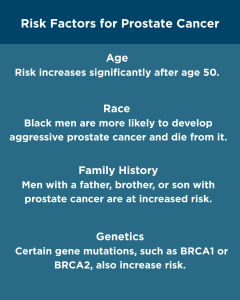When Vernon Owens came back from a work trip in early 2023, he expected to resume his usual health routine. Instead, a routine blood test from his UConn Health primary care doctor set off a chain of events that would change his life and potentially save it.
“I was just going in for a routine physical, but my doctor at UConn Health noticed something unusual in my bloodwork, my PSA was higher than usual,” said Owens. “At first it was around 3.5, and then when they checked it again, it went up a little more. That’s when I knew I needed to take it seriously.”
PSA, or prostate-specific antigen, is a protein produced by the prostate. According to Dr. Ben Ristau, a urologic oncologist and surgical director of Urologic Oncology at UConn Health, PSA screening is the primary tool for detecting prostate cancer before symptoms ever appear. The PSA test is a simple blood test that measures the level of prostate-specific antigen, a protein produced by both normal and cancerous prostate cells. Elevated PSA levels can indicate prostate cancer, but not always.
“PSA can go up for a variety of benign reasons,” Ristau said. “Enlarged prostate, inflammation, urinary tract infections — all of these can cause temporary increases in PSA. That’s why we usually repeat the test and look at other indicators before jumping to a biopsy.”
Ristau recommends that men at average risk begin discussing PSA screening with their doctors around age 50. Those at higher risk, such as Black men or those with a family history, should begin discussions as early as age 40–45.
“There’s also a conversation to be had about when to stop screening,” said Ristau. “For men with a life expectancy under 10 years, continuing PSA testing may do more harm than good. It’s about balancing benefits and risks.”
If PSA remains elevated, doctors may order an MRI of the prostate to look for suspicious areas and evaluate prostate size. If necessary, a targeted biopsy follows.
“The majority of prostate cancers are caught early because of PSA screening,” said Ristau. “It’s a simple blood test, but interpreting it isn’t always simple. PSA can be elevated for many reasons that aren’t cancer, such as inflammation or an enlarged prostate. That’s why it’s important to follow up with diagnostic tests, like MRI and biopsy, if it remains high.”
Prostate cancer is the most commonly diagnosed non-skin cancer in American men. About 1 in 8 men will be diagnosed with it in their lifetime. The good news is that most prostate cancers are slow-growing and highly treatable, especially when caught early.
“The majority of prostate cancers don’t cause symptoms until they’re advanced,” explained Ristau, “That’s why PSA screening is so important, it can detect cancer long before symptoms appear.”
 The prostate is a small gland in the male reproductive system, located just below the bladder. It produces seminal fluid that nourishes and transports sperm. Prostate cancer begins when cells in the prostate start to grow uncontrollably.
The prostate is a small gland in the male reproductive system, located just below the bladder. It produces seminal fluid that nourishes and transports sperm. Prostate cancer begins when cells in the prostate start to grow uncontrollably.
“Most men will develop some form of prostate cancer if they live long enough,” Ristau said. “But not all prostate cancers are life-threatening. The key is knowing which ones need treatment and which can be safely watched.”
In Owens case, his PSA continued to rise. An MRI revealed an abnormal area, and a biopsy confirmed prostate cancer diagnosis. Fortunately, it was localized and caught before it spread. He was then referred to Ristau to discuss his options.
“He came in with an elevated PSA, had an MRI that showed some abnormalities, and a biopsy confirmed the diagnosis,” said Ristau. “Like with all my patients, we had a heart-to-heart discussion about the best path forward.”
That conversation included all the options: active surveillance, radiation, hormone therapy, or surgery to remove the prostate.
Not all prostate cancers need to be treated right away. Many are low-grade and slow growing.
“For those cases, we recommend active surveillance,” said Ristau. “That means regular PSA tests, MRIs, and occasional biopsies to monitor for changes. The goal is to avoid unnecessary treatment and its side effects while staying ahead of any progression.”
Research shows that many men on active surveillance never require treatment, and even those who eventually do often benefit from years of preserved quality of life.
“It was scary,” Owens recalled. “I had to learn fast, about the Gleason score a grading system used to assess how aggressive prostate cancer cells look under the microscope, about staging, about the options I had. I went home, did my homework, and got two more opinions,” Vernon said. “Ultimately, after talking with my wife and weighing the risks, I decided surgery was right for me.”
“There are several treatment paths, including radiation, hormone therapy, or active surveillance if the cancer is low risk,” said Ristau. “In Vernon’s case, surgery was the most appropriate next step.”
On October 2, 2023, Owens underwent a robotic prostatectomy performed by Ristau using the Da Vinci robotic system. The minimally invasive approach meant a quicker recovery and less pain.
“I expected it to be a lot more painful,” Owens recalled. “But I was only in the hospital for one day. They told me I had to be able to walk and use the bathroom I did both right away.”
He credited his smooth recovery in part to years of martial arts training, which gave him strong core control and prepared him for the pelvic floor exercises recommended after prostate surgery to help manage incontinence.
“By the next day, I was walking laps around the hospital wing,” he said. “The care I received was exceptional. Everyone was professional, responsive, and made my wife and me feel supported through the entire process.”
Follow-up PSA tests after surgery showed the best possible result: less than 0.01, indicating no evidence of cancer in the body.
Now cancer-free, Owens is back to work and living his life. He continues regular follow-up visits with Ristau and has become a vocal advocate for men’s health within his professional and personal circles.
Screening matters, especially for those at higher risk. This includes men with a family history of prostate cancer, those with BRCA gene mutations, and Black men, who are more likely to develop aggressive forms of the disease.
“Men of color especially need to be aware,” Owens said. “We sometimes wait too long to get checked. I want other men, especially Black men, to understand how important it is to stay on top of your health. Prostate cancer doesn’t have to be a death sentence if you catch it early.”
“I tell my friends: don’t wait. If you feel off, get checked. If you’ve never had a PSA test, ask for one. And if prostate cancer runs in your family, start screening early, says Owens”
He’s also grateful for the care he received at UConn Health.
“Dr. Ristau and his team were phenomenal,” he said. “He answered all my questions, even the hard ones. He made me feel confident and calm during one of the most uncertain times in my life. Thanks to him, I get to tell my story and hopefully help someone else catch it early too.”
Learn more about PSA screening and prostate cancer care at Prostate Cancer Symptoms & Treatment | UConn Health



